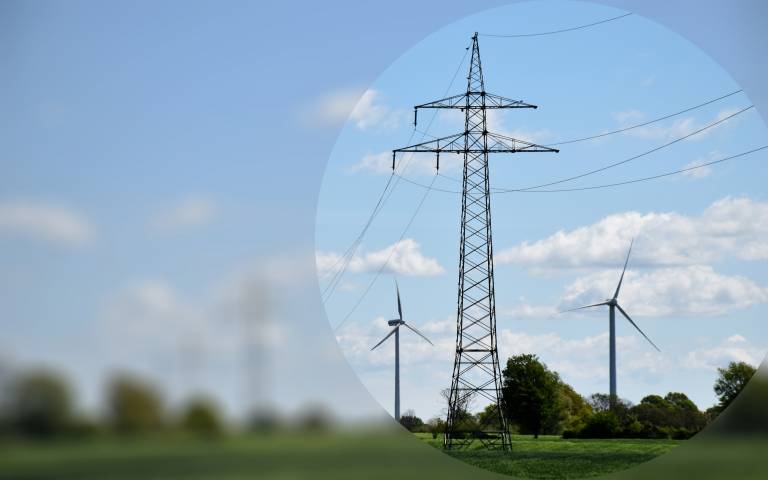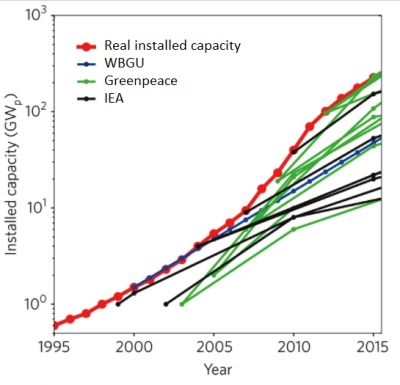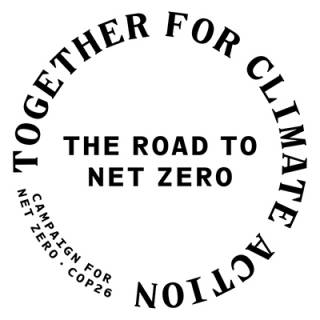How do policy-makers plan for net zero given all the uncertainties?
7 June 2021

At a glance
- Energy models have been widely applied to support policy-making for decarbonisation in the UK, particularly in relation to setting carbon budgets and net-zero targets.
- Uncertainties related to technology development and behavioural changes, as represented in energy models, inevitably challenge the credibility of their results.
- These uncertainties can be addressed by developing new modelling approaches that better reflect some of these areas, by linking different kinds of models together to get a better representation of real-world interactions, by running models lots of times to see the influence of key assumptions on model results.
- Transparency about a model’s assumptions and structure is important for its results to be understood and have credibility.
The use of numerical models in energy policy making
To reach the UK’s ambitious net-zero emissions targets by 2050, the whole energy system must be dramatically transformed. A wide range of low-carbon technologies needs to be deployed quickly and at scale to replace less efficient and higher-carbon technologies (e.g. gasoline vehicles and gas boilers) in buildings, transport and industry. These replacements must be able to fulfil consumers’ demands for services, such as heating, lighting and mobility, reliably, and must not impose hardships on disadvantaged and vulnerable social groups, such as those living on low incomes.
Policy-makers face daunting challenges when developing decarbonisation policies to drive this transformation. To assist them, they often turn to numerical models of the energy system or of energy uses to help them determine the most cost-effective combination of technologies and behaviours to achieve decarbonisation under a wide range of different assumptions about the future. Models could consider, for example, the stability of the electricity system with a large share of intermittent renewables, the cost of energy, and wider issues of environmental protection. The UK TIMES model (a model of the energy system jointly developed by the UK Government and the UCL Energy Institute) has been used to support the development of the UK’s 5th and 6th ‘Carbon Budgets’ (decarbonisation targets for 2030 and 2035), as well as the strategies for achieving net zero emissions by 2050. National Grid, the UK’s electricity transmission grid operator, also used this model to explore four decarbonisation scenarios with different projections of societal change and technological developments.
To determine the most cost-effective pathways, the models need to contain numerous details of different potential technologies, especially their cost and performance and how they might develop in the future. However, the future is highly uncertain. It is impossible to know exactly how technologies will develop. For instance, the cost of solar PV dropped by 82% in the past ten years alone, exceeding even the most optimistic expectations of scientists and policy-makers, with installed capacity consistently surpassing projections by different organisations using various numerical models, as shown in Figure 1. As such, it is relatively easy for models to substantially underestimate the potential role of key technologies even a few years out.
With such uncertainties, the most ‘cost-effective’ pathways to net zero according to different models could vary dramatically. Policy-makers must be aware of these uncertainties, and still be able to take decisions despite them. They can be helped by better representation of uncertainties in the models.

Figure 1. The consistent underestimation by different models of real installed PV capacity (about 0.2 GW in 1995, 5.1 GW in 2005, 22.2 GW in 2015, and 71.4 GW in 2020) in the past (source: Creutzig et al., 2017)
Coping with decarbonisation uncertainties
The future in relation to decarbonisation is inherently uncertain, for many reasons, apart from uncertainties in the development of new technologies. These uncertainties include the effectiveness of policies in practice, the performance of the technologies they seek to install, and the availability of the resources required for the technologies. Each of these uncertainties is compounded by uncertainties in how people will respond to the policies and new technologies. A particular example is heat pumps, which are likely to be a crucial technology to decarbonise heating in the UK, but installers’ and the public’s unfamiliarity with them, compared to gas boilers, is a key factor preventing their further promotion and adoption.
To address these issues, a numerical model would ideally represent all the complex interactions between technologies, people, the economy and the environment in a single modelling framework so the impact of different policy decisions could be clearly considered. However, in practice, all models have their own specific strengths and weaknesses when they are applied to support policy-making. Sometimes the models can be linked, with the outputs of one model fed into another, in order to benefit from the strong points of both. Or a single model can be run lots of times with adjustments in inputs and working assumptions, to assess the influence of various different elements of uncertainty on model results.
Such scenario analyses are common. In practice, they usually consider only a limited number of ‘futures’ based around developments in a few key technologies or system features. This approach is widely adopted for its simplicity, since policy-makers are often most interested in the differences between a few key plausible developments. For example, when the Climate Change Committee (CCC) formulated its advice for setting the UK’s 6th Carbon Budget, various plausible changes to society, behaviour and technology were used to formulate narratives for different scenarios (CCC 2020).
To improve the representation of policy-related dynamics in existing energy models, new modelling approaches can be introduced to cover missing or under-represented policy mechanisms. Policy-makers can also use multiple models to cover a broad range of policy dimensions. And they can seek to build up their in-house capacity through working closely with external research teams, in order to identify model weaknesses and to conduct interdisciplinary studies. Throughout, credibility of the results will require transparency of the assumptions and model structure through which they have been obtained.
Conclusion
Energy models are key tools underpinning policy-making for decarbonisation. However, the assumptions these models make about future developments across technology, the economy and society are often highly uncertain. Through the influence of these models in informing policymakers, these uncertainties can be highly consequential to choices they make, for better or worse. To gain insights into the importance of these uncertainties, new modelling approaches can be developed to consider under-represented policy mechanisms. Policy makers can also use multiple energy models collaboratively to represent complex systems better. Lots of model runs under different assumptions can further support robust policy-making. Finally, model transparency is required so that people can understand how model results have been derived.
Key references for further information
- Creutzig, F., Agoston, P., Goldschmidt, J. et al. The underestimated potential of solar energy to mitigate climate change. Nat Energy 2, 17140 (2017).
- CCC (2020). The Sixth Carbon Budget: The UK’s path to Net Zero. Committee on Climate Change. London
 Close
Close


